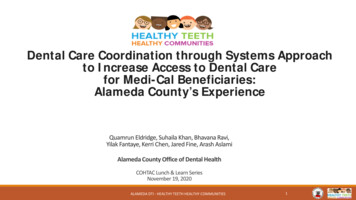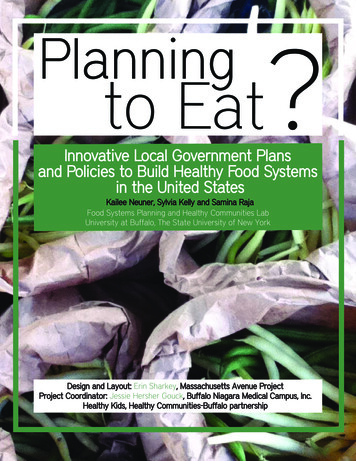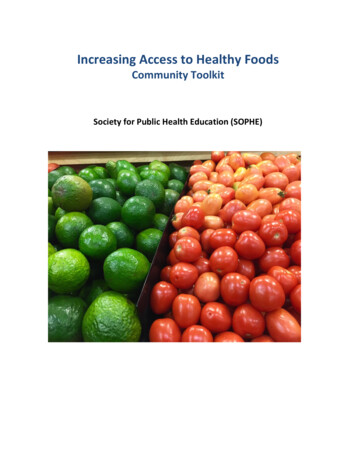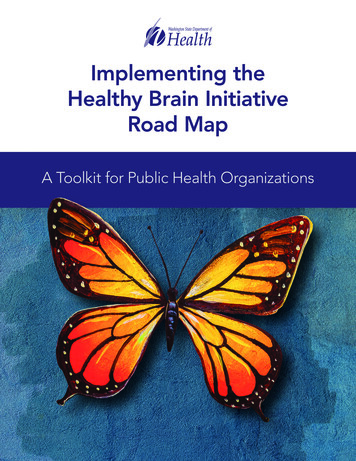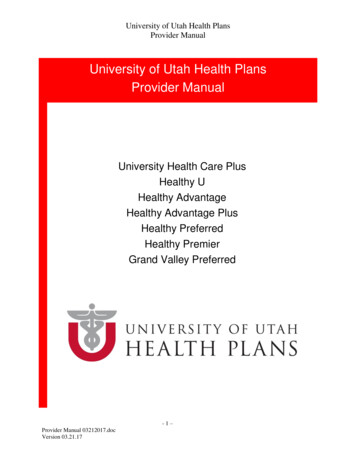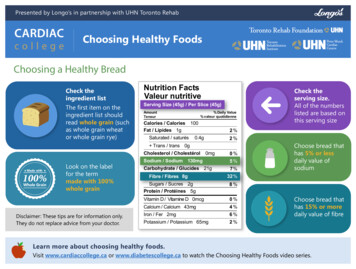
Transcription
2U58DP002005-09Georgia Healthy Communities Initiative; Georgia’sTobacco Use Prevention Program - DP14-1415Cooperative Agreement Final ReportGrant Number: 2U58DP002005-09Reporting Period: March 29, 2009 – March 28, 20151
2U58DP002005-09Authors: Emma Bicego, MPH; Kia Powell-Threets, M.S; Oluwayomi, Fabayo, MPH; Kayla Lloyd,MPH; Anne-Marie Coleman, MPH; Alina Chung, MPH; Keith, Bussey, MPH; Chanelle Jefferson,MPH; Antionette Lavender, MPH; Rana Bayakly, MPH; Kenneth Ray, MPH; Jean O’Connor, JD,Dr PH. Chronic Disease Prevention Section, Georgia Department of Public Health.Acknowledgements: The authors wish to thank the following persons and agencies for theirsupport in realizing success during this cooperative agreement: Dr. Brenda Fitzgerald,commissioner and the Leadership Team of the Georgia Department of Public Health, the Officeon Smoking and Health at the Center for Disease Control and Prevention, the Georgia AmericanLung Association, the Georgia American Cancer Society, the Georgia Heart Association,Americans for Non-Smokers’ Rights, Georgia State University Institute of Public Health, EmoryUniversity School of Public Health, Mercer University School of Public Health, Columbus StateUniversity School of Health, Physical Education, and Exercise Science, and the staff of the eighteenhealth districts.2
2U58DP002005-09Table of ContentsBackground . 4Significance of Public Health Problem . 5Summary of Significant Accomplishments During the Award Period. 9Partnerships . 20Trainings . 21Evaluation . 21Table 1: Smoking among Georgia adults by selected demographic factors, 2013 . 6Table 2: Estimated reach of current Georgia smoke-free or tobacco-free policies, 2013 . 7Table 3: Youth Tobacco Use Prevalence Rates By Type Of Tobacco And School Level, Georgia 2013. 7Table 4: Selected Georgia Tobacco Use Prevention Program Partners . 203
2U58DP002005-09BackgroundEstablished in 2000, the Georgia Tobacco Use Prevention Program (GTUPP) is a healthpromotion and disease prevention program designed to meet the overall goal of reducing thehealth and economic burden associated with tobacco use. Annually in collaboration with the 18public health districts; non-profit health and community-based organizations; and variouspartners and youth groups, GTUPP plans, implements and evaluates activities designed toreduce tobacco-related illnesses and deaths. Best practice strategies are developed to focus onthe following goal areas: Preventing the initiation of tobacco use among young people Promoting quitting among young people and adults Eliminating exposure to secondhand tobacco smoke Identifying and eliminating the disparities related to tobacco use among various populationgroupsOver the past six years (2009 to 2015), significant short term and intermediate outcomes havebeen achieved in reducing exposure to secondhand smoke in public places, increasing thenumber of smokers and overall tobacco users to participate in counseling and nicotinereplacement therapy activities provided by the Georgia Tobacco Qui Line. These achievementsinvolved collaborations and leadership from a variety of partnering agencies such ascolleges/universities, voluntary health agencies, county health departments and healthdistricts, grassroots organizations, minority organizations, public school districts and otheryouth serving organizations, civic groups, local coalitions and survivors of tobacco-relateddiseases.Statewide and local capacity building to plan, implement, and evaluate evidence-basedstrategies occurred through statewide trainings, opportunities for information exchange,communication channels, toolkit development, and web-based instruction.A surveillance schedule was created during this time period to assure that data collectionoccurred on time and in accordance with CDC protocol. Data sources such as the BehavioralRisk Factor Surveillance Survey (BRFSS), the Youth Risk Behavior Survey (YRBS), the YouthTobacco Survey (YTS), the Adult Tobacco Survey (ATS), the School Health Profile (SHP), variousancillary modules, and monitoring projects all provided much needed information thatdetermined program direction.Evaluation activities occurred internally and externally through approved work plans and orcontracts with vendors implementing deliverables that led to policy, system and environmentalchanges. Logic models were created and modified when needed to reflect shifts in approachesand achievement of out puts and changes in social norms.To monitor all of these activities, program infrastructure consisted of a program manager,administrative assistant, program evaluator, cessation coordinator, youth preventioncoordinator and a secondhand smoke prevention coordinator. Training and technical assistance4
2U58DP002005-09was provided by the program staff and or through contracts with national networks andtrainers of evidence-based strategies.Significance of Public Health ProblemTobacco use is the leading preventable cause of death in Georgia each year, costing the statemore than 11,500 lives per year and nearly 5 billion dollars in direct healthcare and indirectcosts, such as lost wages. Over the last 15 years, adult tobacco use has been declining, with arecent increase in the rate of decline. In 2003, the adult tobacco use rate was above 26 percent.According to the Behavioral Risk Factor Surveillance System (BRFSS), the adult smoking ratesfell from 21.2 percent in 2012 to 18.8 percent in 2013. However, alternative tobacco use rateshave increased, particularly among youth; low income, white, rural males continue to usetobacco at higher rates than the national average; the Medicaid population continues to be twoto three times as likely to use tobacco than the general population; young adults ages 18-24continue to smoke at the highest rates of any age group; and, smokeless tobacco and smokingamong pregnant women remains a significant problem in Georgia. As of 2013, Georgia’s adultsmoking prevalence was above the national average.The 2013 BRFSS indicated that approximately, 18.8 percent (1.3 million) of adults in Georgiasmoked cigarettes, and 4.99 percent (360,000) used smokeless tobacco. Smoking prevalencerates by sex indicated that significantly more adult males (22.5 percent; 775,000) than females(15.4 percent; 574,000) smoked cigarettes and used smokeless tobacco (8.4 percent; 291,000for males and 1.9 percent; 69,000 for females) respectively, (2013 BRFSS). See table 1.Smoking prevalence among the non-Hispanic population, indicate that significantly more nonHispanic (NH) white male (11 percent; 221,000) used smokeless tobacco than NH black male (5percent; 46,000) and more non-Hispanic black female (3 percent; 36,000) used more smokelesstobacco than non-Hispanic white female (1 percent; 28,000). Use of cigarettes among NH whitefemales (18 percent; 391,000) was significantly higher that among NH black females (13percent; 145,000). (2013 BRFSS)Other social demographic characteristic differences including mental health, education andincome indicated that smoking prevalence among adults with depression was over twice therate of adults without depression, 35 percent (440,000) and 15 percent (900,000), respectively.Adult males in Georgia with less than a high school education had a significantly higher smokingrate (29 percent; 350,000) compared to any other educational group. Adults in Georgia withless than a high school education also have the highest rates of smokeless tobacco use (9percent; 105,000). Adults with an annual household income of under 15,000 a year in Georgiahave the highest rate of smoking (32 percent; 250,000) and smokeless tobacco use (6 percent;46,000) compared to all other incomes (2013 BRFSS). See table 1.5
2U58DP002005-09Table 1: Smoking among Georgia adults by selected demographic factors, 2013Selected Demographic GroupsSmoking Prevalence Est. # SmokersAll Adults 18 Years or Older18.81%1,349,214Young Adults 18-24 Years16.51%157,915Youth smoking prevalence rateEstimated Adults with Income Below Federal Poverty Level 31.73%262,582Adults with Less than a High School Education (25yoa )29.33%349,932Male adults22.54%775,096Female adults15.38%574,118Adults who are Medicaid Enrollees26.3%94,153Women who use tobacco the first 3 months of pregnancy15.9%21,026Women who use tobacco the last 3 months of pregnancy6.2%8,189Non-Hispanic (NH) White Female adults18.47%391,428NH Black Female adults12.81%143,509NH White Male adults22.92%458,219NH Black Male adults22.66%213,511Annual household income, adults 15,00031.73%246,229 15,000- 24,99925.57%302,466 25,000- 34,99920.74%168,273 35,000- 49,99919.83%178,351 50,000- 74,99912.97%114,909 75,000 or More10.71%165,682Have depression, adults34.75%436,760Have not had depression15.33%900,839The overall rate of smoking among high school students decreased in Georgia almost 25percent from 17 percent in 2011 to 12.8 percent in 2013. The prevalence of current tobacco useby type of tobacco among youth in 2013 was as outlined in table 2. Youth were more likely touse cigars than cigarettes. Among middle school students tobacco use indicated cigarette use of4 percent (14,000); cigar/ cigarillo use of 5 percent (18,000); and smokeless tobacco use of 4percent (13,500). High school students were more likely to smoke cigars/cigarillos (14 percent;61,000), followed by cigarettes (13 percent; 53,000), and smokeless tobacco (9 percent; 42,000)(2013 YRBS).Tobacco use by sex among youth in 2013, showed that male middle school (5 percent; 9,800)and high school (16 percent; 35,000) students were significantly more likely to use smokelesstobacco than female middle school (2 percent; 3,700) and high school (3 percent; 6,000)students (2013 YRBS). By race, Non-Hispanic (NH) white (19 percent; 35,600) and Hispanic (13percent; 5,000) high school students were significantly more likely to smoke cigarettes than NHblack (5 percent; 7,700) high school student and NH white high school (12 percent; 25,000)students were significantly more likely to use smokeless tobacco than NH black high school (4percent; 7,000) students. (2013 YRBS)6
2U58DP002005-09Table 2: Youth Tobacco Use Prevalence Rates By Type Of Tobacco And School Level, Georgia2013Type of eHookahe-cigs *14Smokeless Bidistobacco92689543341Source: 2013 YRBS and 2013 YTS*And, while Georgia exceeds the national averages for persons who report they live in a tobaccofree home and for tobacco-free public schools, colleges and universities, because Georgia doesnot have a comprehensive smoke-free indoor air law, not all people in Georgia are protectedfrom tobacco use while at home, school, or work (See Table 3). Although they are among thelargest agencies, only 3 of the state’s 125 state agencies are tobacco-free (Department of PublicHealth, Corrections, and Mental Health). And, not all hospitals are tobacco-free, nor are all localhealth departments.Table 3: Estimated reach of current Georgia smoke-free or tobacco-free policies, 2013Comprehensive SFEstimatedGeorgiaLocationor TF PoliciesTotal #Population ProtectedMunicipalities3536166, 388Counties1159278,434K-12 Schools981811,375,000Colleges and Universities44126450,000Public Housing218851400State Agencies312575,000Hospitals117154112,000Local Health Departments1241591,000,000State Capitol1175,408Licensed Early Care Settings60006000400,000Private homes1,056,6841,243,158 3,592,727Total7,409,969In 2013, the five public health Districts characterized with smoking prevalence in the upperquartile (25th percentile) of smoking prevalence among public health districts in the state ofGeorgia include LaGrange, South Central (Dublin), North Central (Macon), West Central(Columbus), and Coastal (Savannah). Both LaGrange and West Central (Columbus) public healthdistricts have remained in the upper quartile (25th percentile) in 2012 and 2013 (2012 and 2013BRFSS).Northwest (Rome) public health district has remained in the upper 25 th percentile of ageadjusted lung cancer incidence cases among males and females in 2010 and 2011. Additionally,7
2U58DP002005-09North Georgia (Dalton) Public Health District is in the upper 25 th percentile of lung cancerincidence cases among females in 2010 and 2011. The Cobb/Douglas, West Central (Columbus)and Southwest (Albany) Public Health Districts were also in the upper 25 th percentile amongfemales in Georgia. The Northwest (Athens) and Southeast (Waycross) public health districtshave also remained in the upper 25th percentile of age-adjusted lung cancer incidence rates in2010 and 2011 for males. Additionally, South Central (Dublin) and East Central (Augusta) PublicHealth Districts are in the upper 25th percentile among males.The rate of secondhand smoke exposure among Georgia adults decreased from the 2009 ATSsurvey to the 2014 ATS survey. Although the percentage of adults exposed to any secondhandsmoke decreased by 7 percent ( 42 percent in 2014 as opposed to 45 percent in 2009); still 3.1million people had been exposed. The rate of secondhand smoke exposure in public decreasedonly 3 percent from 32 percent in 2009 to 29 percent in 2014 also 2.1 million people had beenexposed in public places. (ref. 2009 and 2014 ATS). In the previous seven days before the YTS,approximately 40 percent (150,000) of middle school students and almost half (49 percent;225,500) of high school students were exposed to secondhand smoke (SHS) either at home, in acar, at school, or in a public place (2013 YTS).8
2U58DP002005-09Summary of Significant Accomplishments During the Award PeriodProject Period Objective: T1 Decrease the proportion of population reporting exposure tosecond hand smoke in the workplace from 24 to 22 by March 2015. OngoingGeorgia does not have a comprehensive smoke-free indoor air law. The current law allowssmoking in bars, and some restaurants and hotels. Literature indicates that interventions thatare designed to educate the public about the adverse effects of second hand smoke andencourages the public to support stronger smoke free air laws are the most effective inprotecting the public from the dangers of exposure to secondhand smoke. To achieve this inGeorgia the five city project was implemented. The aim of this project is the adoption of city orcounty-wide model smoke-free ordinance with the ultimate outcome to strengthen the 2005Georgia Smoke-free Air Act (Senate Bill 90) which allows numerous exceptions but gives theauthority to local and regional jurisdiction to adopt and enforce stricter smoke-free legislation.Five Georgia cities namely Atlanta, Augusta, Macon, Savannah and Columbus were selected toparticipate in the project based on the prevalence of tobacco related diseases and populationdisparities.Progress: According to the 2014 Georgia Adult Tobacco Use Survey, 24% of all Georgians reportexposure to second hand smoke in the work place. The five City project was created to educate the population of Savannah, Augusta, Macon,Columbus and Fulton County about the dangers of tobacco use and exposure to secondhand smoke. These cities were identified as disparity districts at the implementation of theproject. Consequently the following progress was made:o City of Savannah and Chatham County adopted and implemented a smoke freeordinance. Later Pooler city also adopted an ordinance, ripple effect from SavannahCity.o City of Augusta in Richmond County created a coalition to support the adoption ofan ordinance. Thus far the ordinance has not been adopted but educationcampaigns continue to happen in the area.o City of Macon in Bibb County – a coalition was created but lacked strong localsupport and was not very active. The North Central Health District conducted aHealth Needs Assessment for Macon/Bibb and the data collected shows the burdenof tobacco use in the community. The Health Promotion Coordinator for the NorthCentral Health District (Macon) continues to work with the Georgia Tobacco UsePrevention Program to identify new coalition members and strong local leadership.o City of Columbus in Muscogee County created a coalition to support the adoption ofan ordinance. Thus far the ordinance has not been adopted but educationcampaigns continue to happen in the area.o Fulton County Coalition has educated the Fulton County Commissioners and FultonCounty community on the dangers of exposure to secondhand smoke in Fulton9
2U58DP002005-09County. The coalition is currently focused on four cities within the Fulton County:City of Sandy Springs, City of Roswell, City of Chattahoochee Hills and Union City.o Unanticipated outcome – Cobb2020 Coalition: Kennesaw City Council in CobbCounty adopted a tobacco free parks, recreation and cemeteries policy in the City ofKennesaw protecting 30,000 Kennesaw residents. The policy includes prohibition ofe-cigarette use.Project Period Objective: T10 Increase the percent of adult GTQL callers referred by ahealthcare professional from 17 to 19 by March 2015. – OngoingProgress: At the end of the project period, 14.6% of the GTQL callers reported having been referredto the quitline by a healthcare provider. Though the absolute numbers of callers referred bya healthcare provider increased, the percentage was lower at the end of the reportingperiod than the baseline because more and more people are hearing about quitline fromother sources such as TV and radio.Objective: T.10.1 Increase the number of evidence-based health communicationinterventions targeting healthcare professionals servicing male adult tobacco users indisparate public health districts that promote the benefits of and access to the GeorgiaTobacco Quit Line from 0 to 2 by March 2012. – Target met and ongoingProgress: At the end of the reporting period, a total of 9 communication interventions regarding theClinical Guidelines for Tobacco Use Prevention and the services of the Georgia TobaccoQuitline Services to different health care providers, health care groups and employees weredelivered. Georgia Tobacco Quit Line Brochures and Healthcare Provider Fax Back Referral Packetswere disseminated to various healthcare and academic organizations with large male adulttobacco users included. The institutions included: Georgia Military College, North sideHospital, Piedmont Newnan Hospital.Objective: T.10.1a Increase the number of evidence-based health communicationinterventions targeting healthcare professionals servicing pregnant and postpartum femaletobacco users in disparate public health districts that promote the benefits of and access tothe Georgia Tobacco Quit Line from 7 to 11 by March 2015. - ongoingProgress: At the end of the reporting period, a total of 10 communication interventions in form ofGeorgia cAARds Program webinars series, targeting pregnant and postpartum women, weredeveloped and delivered to health care providers and organizations. The webinar Series10
2U58DP002005-09 covers the Healthy People 2020 National Objective MICH18 which involves reducingpostpartum relapse of smoking among women who quit smoking during pregnancy. Thewebinar will provides healthcare professionals insight on how to achieve this objective.DPH launched a month-long TV media campaign (Visual Echo) in six public health districts:Southwest (Albany), East Central (Augusta), West Central (Columbus), North Central(Macon), Northwest (Rome) and Southeast (Waycross) to raise awareness among femalesof child-bearing age and healthcare providers about the adverse health outcomesassociated with smoking during pregnancy.Objective: T11 Increase the proportion of recent successful quit attempts (3.13.2) from 54 to59 by March 2015. – met and Ongoing According to the 2013 Behavioral Risk Factor Surveillance Survey (BRFSS), approximately59% (789,000) of current adult smokers in Georgia made a quit attempt in the past year.The November 2014 quit rate among GTQL users was reported at 33%, surpassing thenational target of 31%. This was an increase from 31% the previous year, November 2013.Objective: T.11.1 Maintain the number of disparate health districts that offer free NicotineReplacement Therapy (NRT) support of the Georgia Tobacco Quit Line for uninsured adultsfrom 6 to 6 by March 2014. Target metProgress: By the end of the reporting period, Free FDA-approved NRTs offerings in the form ofpatches or gum was offered to all uninsured residents in all 18 Health Districts in Georgiawho called the quitline and were ready to quit within 30 days. Readiness to quit wasassessed by the GTQL Counselors. GTUPP was able to expand the free NRT offerings withfunding from CDC: FOA# CDCRFADP121214PPHF12/1U58DP00401701Tobacco Cessationand Quitline Expansion Project/Approaches for Ensuring Quitline Capacity.Project Period Objective: T12 Increase the proportion of health care professionals who advisetobacco users to quit from 47 to 50 by March 2015. - Ongoing Data from the 2009-2010 Adult Tobacco Survey revealed that 47% (738,000) of tobaccousers who had seen a doctor in the previous year had been advised by a health professionalto quit smoking or using any other tobacco products. Results from the more recent jective: T.12.1 Increase the number of local health departments in disparate healthdistricts that adopt PHS Clinical Practice Guidelines for Treating Tobacco Use and Dependencefrom 5 to 10 by March 2014. Ongoing11
2U58DP002005-09Progress: Only 2 health districts (Macon and Waycross) implemented the Georgia cAARDs program.Currently only Waycross is actively implementing in all its county health department clinics. There are plans in the upcoming, Cooperative Agreement of 2015-2020 to expand theGeorgia cAARds Program into additional public health districts including Dublin, LaGrangeand Albany. This expansion should result in an additional 20 local (county) healthdepartments adopting and implement the Georgia cAARds Program.Project Period Objective: T2 Increase the number of statewide advisory group to assist GTUPPto plan, implement and evaluate tobacco control programs from 0 to 1 by March 2015. Targetmet and Ongoing The advisory council was officially formed on February 12, 2014. The statewide councilassisted GTUPP in developing the goals, objectives and strategies for the next five years(2014 - 2019) and participated in discussions pertaining to the rise in e-cigarette use byyouth and adults, overall tobacco use by youth and adult disparate populations. Over aseries of conference calls and one face-to-face meeting, the advisory council finalized theirrecommendations to the leadership of the Georgia Department of Public Health. Thestatewide advisory council consists of nine members that represent business, schools ofpublic health in Georgia, insurance interest, and voluntary health agency and public healthProgress: The Georgia Tobacco Prevention Advisory Council met with the commissioner of theGeorgia Department of Public Health to discuss their recommendations toward theevidence-based interventions for the next five years (Year 2020). Advisory Council membershave participated in various projects pertaining to their availability and level of expertise(ex. engagement in the planning of the Georgia Board of Regents University Tobacco-FreePolicy Planning meeting on July 10, 2014). The Advisory Council members assisted GTUPP on the development of the Memorandum ofUnderstanding between the Georgia Department of Community Health and the GeorgiaDepartment of Public Health towards a project to develop a Medicaid Match for tobaccocessation.Project Period Objective: T3 Increase the number of statewide coalition to assist GTUPP toplan, implement and evaluate tobacco control programs from 0 to 1 by March 2015. Targetmet and OngoingProgress: The coalition was officially formed on February 18, 2014. The statewide coalition consists offourteen member organizations with identified representatives. The statewide coalition12
2U58DP002005-09 assisted GTUPP in developing the goals, objectives and strategies for the next five years(20142019) and participated in discussions pertaining to the rise in e-cigarette use by youthand adults, overall tobacco use by youth and adult disparate populations. Over a series ofthree conference calls and one face-to-face meeting, the statewide coalition finalized theirrecommendations to the leadership of the Georgia Department of Public Health. Thestatewide coalition consists of fourteen member organizations with identifiedrepresentatives.The Georgia Tobacco Excise Tax Project developed state and local strategies to increase thetobacco excise tax from 0.37 to 1.37 for all tobacco products. GTUPP staff continued toserve as part of the excise tax workgroup. An increase in the excise tax from 0.37 to 1.37would help decrease the youth smoking prevalence over time.Progress: The Georgia Comprehensive Cancer Control Prevention & Education Workgroup conductedmonthly planning meetings towards the development of a plan to educate targeted electedofficials within the state legislature on the virtues of increasing the price of all tobaccoproducts towards the reduction of youth tobacco use in Georgia. A face to face training onincreasing the price to tobacco products took place on October 14, 2013 in Macon, Georgia.Representatives from the Campaign for Tobacco-Free Kids and American Cancer SocietyCancer Action Network facilitated the meeting. The training led to the development of keymessages, visiting campaigns from other states, and learning from persons who have leadeducation campaigns in other states. Members of the workgroup identified adult leaders ofyouth groups that have participated in tobacco use prevention activities in the past threeyears to participate in future meetings and conference calls. The Tobacco Subgroup of the Georgia Comprehensive Cancer Control Plan, Prevention andEducation Workgroup continued conducting monthly meetings to determine the course ofaction for the future of the education campaign. House Bill 251 proposed the prohibition ofthe sale of tobacco products to minors under the age of 18 to include e-cigarettes. Thelanguage will add to the definition of “alternative nicotine products” but excludes anyproducts regulated as a drug by the Food and Drug Administration. The workgroupdetermined that state legislators would benefit from an education campaign on ecigarettes. Talking points and a one-pager was created and distributed to the legislators.The workgroup agreed to discuss raising the minimum purchase age to purchase tobaccoproducts from 18 to 21.Project Period Objective: T4 Decrease the proportion of prevalence of tobacco use amongyoung people from 23 to 21 by March 2015. Target met and ongoingPlease note: The 2011 BRFSS methodology changed and therefore, smoking prevalence trendsbefore and after 2011 are difficult to monitor. Regardless of change of methodology tobaccouse prevalence rates among the youth decreased. Table below shows 2013 youth tobacco useprevalence rate by type of tobacco and school level:13
2U58DP002005-09Objective: T.4.1 Increase the number of Georgia schools districts that adopt a model 100%Tobacco-Free School policy from 98 to 101 by March 2015. Target met and ongoing Current measure 101 school districts have adopted and implemented the CDC model 100%Tobacco-Free School policy.Collaboratively worked with partners from across the state to identify and train youthgroups.The Preventing Youth Initiation workgroup (made up of key shareholders) was involved withidentifying youth groups and adult leaders.Youth Empowerment Solutions (YES) was used to train youth on advocacy around TobaccoFree Policies.Middle and High school age students from across the state were represented at the youthsummits.DPH staff provided technical assistance (TA) to youth for a year after each youth summit tofollow up on policy advocacy work (e.g. youth presenting model100% Tobacco Free SchoolPolicy to school boards).DPH staff conducted monthly calls with Public Health District Coordinators and adult leadersto provide technical assistance.DPH staff created a monthly call template to ensure Public Health District Coordinators andadult leaders understand evaluation indicators related to the Tobacco Free Schools logicmodel. Also, this template allows DPH staff to provide more technical assistance versus onlygetting program updates on the monthly calls.Collaboratively worked with communications office at GDPH to post updated list of schooldistricts that have adopted and implemented the 100% Tobacco Free Schools Policy.In addition to the list of school districts, the website contains information on how one canhelp their school district go tobacco free, and how to enforce the tobacco free school policyafter adoption. Lastly, the website contains information about cessation to ensure thepolicy impacts behavioral change.GDPH Tobacco Epidemiologist personnel update the 100% Tobacco Free Schools Map toshow how many school districts are tobacco free amongst all Georgia school districts. Thereis also a map for Colleges and Universities and Parks a
colleges/universities, voluntary health agencies, county health departments and health districts, grassroots organizations, minority organizations, public school districts and other youth serving organizations, civic groups, local coalitions and survivors of tobacco-related . The Cobb/Douglas, West Central (Columbus) 2U58DP002005-09 .


